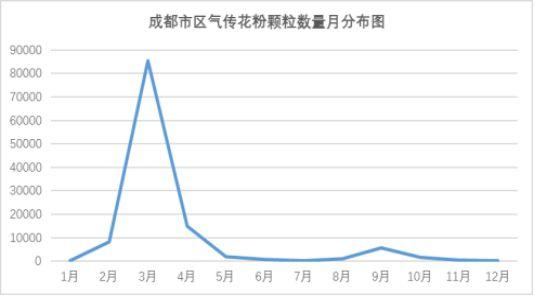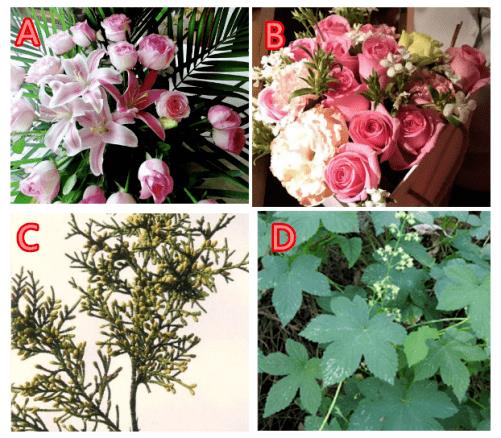In the spring of March, spring blossoms, and it is the right time to enjoy the spring. However, in this good time to enjoy the scenery, people with allergies have such a trouble: they often have itchy eyes, tears, sneezing, stuffy nose and runny nose. In fact, this is mostly hay fever.
Since beginning of spring this year, due to the relatively warm climate, the spring pollen season in Chengdu, Sichuan and other places is one month earlier and lasts longer than that in the northern region. A beautiful spring will be a disaster for pollen allergy patients.
According to the monitoring of the Allergy Response Center of West China Hospital, the amount of airborne pollen in recent years is 19 times that of 30 years ago, and some of them are 80 times that of 30 years ago, so the number of people with pollen allergy is increasing.

Every spring from February to May, especially in March, the pollen quantity reaches its peak.
What is hay fever?
Pollinosis is caused by patients’ allergy to plant pollen, which mainly involves eyes, upper respiratory tract and skin. In spring, poplar, willow, sycamore and other trees are the main pollen, and a few patients may be caused by fungi, dust mites or other inhalants or foods with obvious seasonality. The types of allergens are complex, and many people are allergic to them repeatedly, which may be because they are repeatedly exposed to allergens without knowing it.
The clinical manifestations of pollinosis include symptoms and signs of different parts such as eyes, upper respiratory tract and skin. Pollen allergic rhinitis can be characterized by itchy nose, sneezing, runny nose, blocked nose and poor breathing. Pollen allergic asthma is characterized by paroxysmal cough, dyspnea, white foam-like mucus, sudden asthma attack and gradual aggravation, which is no different from normal people after remission; Pollen allergic conjunctivitis can be characterized by itchy eyes and swollen eyelids, often accompanied by watery or purulent mucus secretions; Allergic dermatitis can be manifested as systemic or local erythema, papules, small scales, itching or burning sensation.
Cold knowledge
What makes most people allergic is not flowers, but trees!
Which of the following four ABCD plants do you think is the most likely to cause pollen allergy?

Do you think that the above two kinds of flowers with high face value and bright colors are the "killers" who cause everyone to cough and snot Qi Fei? Wrong, in fact, it is more likely to cause allergies. It is the pollen of the following two seemingly ordinary and harmless trees (C: cypress) and weeds (D: humulus)! Tree pollen is the main cause of allergy in spring, while weed pollen is the main cause of allergy in autumn.
In nature, plants are divided into wind-borne flowers and insect-borne flowers according to the different modes of pollen transmission.
anemophilous flower
"Wind-borne flowers" are flowers that use wind as a pollination medium. These flowers are generally small in size, not bright in color, and even many of them are in a degraded state, with no fragrance and nectaries, so that you can’t see or smell like flowers.
However, wind-blown flowers produce a lot of pollen, with smooth surface and light dry texture. When the wind blows, they can fly to very high and far places, such as the height of 2 or 30 floors.
Representatives of this kind of flowers are: poplar, elm, cypress, birch, ginkgo, phoenix tree and so on.
entomophilous flower
"Insect-pollinated flowers" are flowers that are pollinated by insects such as butterflies and bees. Most of these flowers are bright and beautiful, with fragrance or other smells. The pollen grains are usually relatively large and the yield is relatively small. In addition, they are often stuck together, which is not easy to be blown away by the wind, and it is even more impossible to blow high!
Therefore, in comparison, trees and weeds that are odorless, colorless, tasteless and even do not look like flowering plants are the main culprits of human allergies because of their large pollen yield+easy to be blown high and far by the wind.
Understanding of hay fever in traditional Chinese medicine
There is no name of hay fever in TCM, which can be classified into sneezing, coughing, wheezing, wet sore, addiction rash and other categories according to different clinical symptoms of hay fever.
aetiological agent
Hay fever is essentially an immediate allergic reaction. Traditional Chinese medicine believes that hay fever is due to deficiency of the essence and excess of the essence, and the qi of the lung, spleen and kidney is insufficient, and the exterior of the body is unstable. Once exogenous pathogenic factors such as wind-cold or wind-heat are induced, the lung loses its function, the spleen loses its transport and the kidney loses its function, then the stagnation of qi and water stops phlegm, and pathological products accumulate, either in the eyes, nose, skin or respiratory system.
Pollen, as an allergen, can be regarded as the inducement of diseases after human body feels exogenous diseases, so pollinosis can be classified into the category of exogenous diseases and treated according to syndrome differentiation.
Chinese traditional treatment
The treatment principle of hay fever is to treat the symptoms when it is urgent and the root cause when it is slow. In the acute attack period, expelling wind and evil spirits are the main factors, supplemented by strengthening the body resistance; In the remission stage, strengthening the body resistance and consolidating the exterior are the main methods, supplemented by exorcism. The specific treatment prescription varies according to the disease.
When allergic reaction occurs, in addition to oral decoction, some traditional Chinese medicine methods can be used for treatment, such as acupoint injection, acupoint catgut embedding, acupuncture, ear acupuncture, umbilical therapy, bloodletting at the tip of the ear and so on.
For patients with acute allergy and excessive toxic heat, bloodletting therapy at the tip of the ear is suitable to dispel heat and detoxify. The specific method is that after routine disinfection at the ear tip (both sides), puncture the ear tip with a triangular needle and squeeze out 2-3 drops of blood.

Umbilical therapy refers to making medicine into ointment, pill, and powder, then applying it, taking it, smoking it, moxibustion it, steaming it, ironing it on the navel (called Shenque point in Chinese medicine), then fixing it with gauze or adhesive tape, and uncovering it after 2 hours.
Traditional Chinese medicine believes that umbilical medication can act on the whole body through the connection of the five zang-fu organs, the twelve meridians and the eight strange meridians, so it has a wide range of effects. Fumigation and washing method is to fumigate and wash with decoction of Folium Artemisiae Argyi, Kochia scoparia and Senecio scandens, or fumigate nose, mouth and eyes with medicinal vapor, which has good effect.
Daily precautions
I would like to remind you that people with allergies are easily troubled by pollen when they go hiking. We should take corresponding measures in time to prevent allergies from happening, and we can start from the following aspects.
01
Avoid contact with pollen
In the pollen spreading season, you should wear a mask, a windproof eye mask and a nasal filter if necessary, and use a pollen blocking agent.
Reduce outdoor activities, especially going out at noon and afternoon. It is best to go out for a walk after the rain, when the air is fresh and the pollen is the least affected.
In windy weather, it is best to close the doors and windows to prevent pollen from entering the room when opening the window. An air purifier or fresh air equipment with pollen filtering function can be installed indoors.
Change and clean clothes worn in outdoor activities in time, and dry clothes in a clothes dryer instead of drying clothes outdoors.
02
Principles of daily diet
Strengthen nutrition, eat more light and vitamin-rich foods, and try to eat less high-protein, high-calorie and spicy foods. Preventive medication
Before the pollen stage comes 1~2 weeks, preventive medication can be taken under the guidance of a doctor, which can prevent the onset of hay fever or relieve discomfort. After the symptoms of pollen allergy such as itchy skin, cough and dyspnea appear, you should go to the hospital for treatment in time.
(Sichuan Traditional Chinese Medicine Comprehensive China Traditional Chinese Medicine, west china hospital)
关于作者